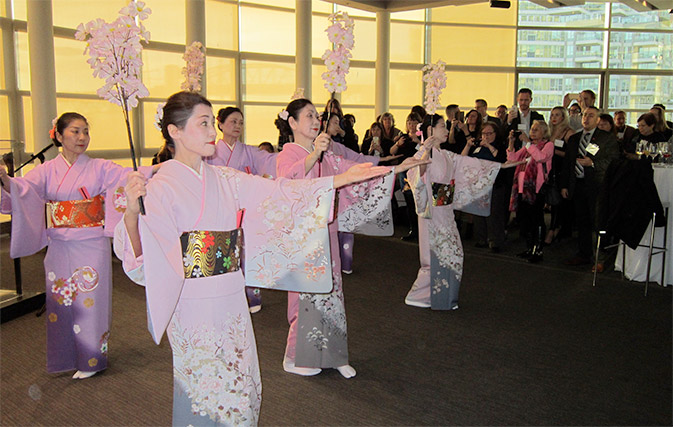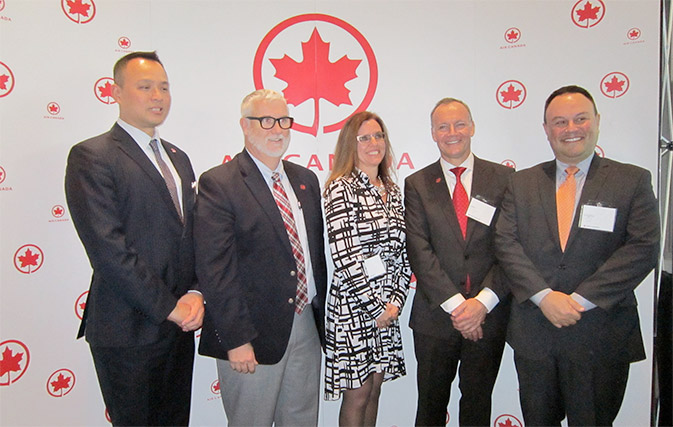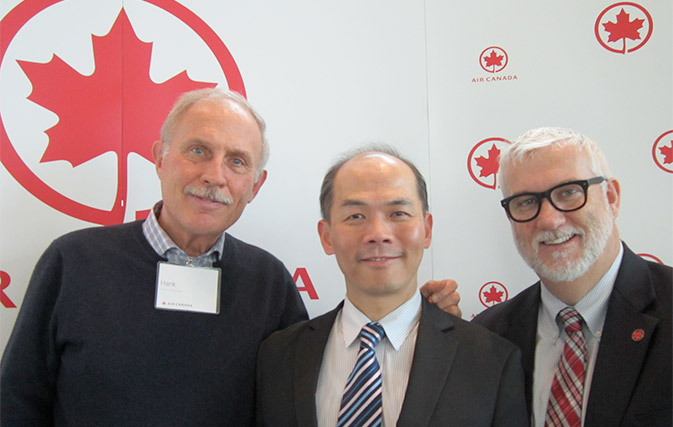VANCOUVER — Air Canada’s roster of new direct flights into transborder and international markets taking off this year drew applause from travel agents attending the airline’s Vancouver launch party at the Waterview events venue.
New 2017 routes offering more direct flights include Vancouver to Boston, Denver and Phoenix in the U.S., Frankfurt and Gatwick in Europe and Nagoya and Taipei in the Asian market.
“We are investing billions of dollars in Western Canada,” said Duncan Bureau, VP Global Sales for Air Canada, as he addressed agents attending the launch.
Vancouver is not only seeing more flights departing from YVR but will also now be home to some of the newly-acquired Boeing 787 Dreamliner aircraft plus others arriving in 2017 and into 2019. It will give Air Canada the reach it needs to provide nonstop service to many of the new destinations and provide better fuel economy and payloads. “This is an incredible investment,” he said, crediting the work of agents in Western Canada.

Air Canada’s launch of new routes out of Vancouver includes Nagoya, Japan. Credit: Jean Sorensen
Bureau said that between 2014 and into 2017, the “footprint” of Air Canada has deepened – and continues to deepen – in the Western Canadian market. “The number of flights that depart Vancouver on a yearly basis has grown over 15%,” he said. “The number of seats has grown 50%.”
As Air Canada heads into its 80th year of business in 2017, the newly announced routes follow on heels of the 2016 expansion which saw Air Canada and Air Canada Rouge start 15 new international routes out of Canada, including the first scheduled service to Africa and 12 U.S. transborder routes.
Air Canada’s daily seasonal service from Vancouver to Boston begins June 23 and continues until Sept. 4 using 120-seat Airbus 319s. Vancouver to Denver will be twice daily beginning May 18 and Vancouver to Phoenix will begin May 1 with daily service. Daily seasonal flights from Vancouver to Frankfurt begin June 1, while three times a week service to London Gatwick begin June 8. Vancouver-Frankfurt flights will be operated with Boeing 787-8 Dreamliners and Vancouver-London Gatwick service will be operated by Air Canada Rouge with Boeing 767-300 ER aircraft.
Vancouver to Nagoya will launch June 1 with three times a week service moving to four times weekly for August and September and also using the Air Canada Rouge B767-300s. Vancouver to Taipei will begin June 8 after 14-year absence. Air Canada started the route in 1999 but suspended it in 2003. Currently it is the only Canadian carrier offering nonstop service on the route and the year-round service will feature the Boeing 787-9 Dreamliner.
The 2016 and 2017 route expansions build on Air Canada’s two major initiatives. The first is a massive fleet renewal program with the emphasis on more wide-bodied aircraft offering lower fuel and maintenance costs and higher per seat pay-loads followed by refreshing is narrow-bodied fleet. The second is a move to direct those aircrafts into lucrative markets, namely the U.S., Europe and Pacific markets, all areas where in 2016 Air Canada saw revenue grow 7.2%, 9%, and 12% respectively. In 2016, 90% of the airlines growth was focused internationally. In the U.S., Air Canada’s strategy is focused on the origins and destination sector of the market but also to attract a large share of the connecting traffic, an area where Air Canada in 2016 saw a significant increase.
Air Canada has identified major gateways in Canada and in Western Canada, those are Calgary and, in particularly, Vancouver – a tipping point into the Asian countries.
Air Canada has on order $12 billion in new aircraft. In 2016 and early 2017, it received 12 more 787 Dreamliners, bringing its total to 24. Six more will be delivered throughout the rest of 2017 and the fleet number will rise to 37 within the next two years. It also has an option for with Boeing for 15 more. AC also completed the reconfiguration of its entire Boeing 777 fleet of 25 aircraft that of the Dreamliner cabin design. Both aircraft now give it increased wide-body capacity.
In terms of narrow-body fleet conversion, in 2017, the first of 61 Boeing 737 Max aircraft will arrive and in 2016, Air Canada finalized the arrangements for 45 Bombardier CS 300 C Series aircraft with option for another 30. The aircraft give a fuel saving and payload return of approximately 15%.
The challenge now facing Air Canada is finding routes for the mega-purchase of new aircraft and increased number of seats. The new routes announced with nonstop service are finding favour with travel agents.

Air Canada executives were on hand for the Vancouver launch party for the new 2017 U.S. and international routes. Left to right are: Timothy Liu, Senior Director of Commercial Strategy; Duncan Bureau, VP Global Sales; Bonnie Walker, Director of Sales for Western Canada; VP Commercial Sales John MacLeod; and Virgilio Russi, Senior Director of Sales for Canada. Photo credit: Jean Sorensen
“It is going to be great for those people looking for a direct flight,” said Michelle York, an agent with TSI Travel. She said corporate travellers as well as middle-aged and senior travellers are all key markets for direct routes. “It is really only the young people who are concerned about price-points and more willing to stopover,” she said.
“It is definitely good for business,” said Sena Dolanjski of Sena Travel, a 26-year veteran of the industry who said the majority of her sales are with Air Canada and Lufthansa. New destinations increase the sales potential for agents and also provide additional destinations and departures for travellers. “You are able to promote further out,” she said.
The convenience of direct flights is trumping the pocketbook. “People do not mind paying more for direct flights,” she said, if travel is made easier. Connecting flights or layovers all come with the rigors of going through another security screening, the chance of missing a flight, dealing with more complex airports and even losing luggage.
Travel agent David Elmy with The Travel Group said there are a growing number of direct service flights, in a response to the market. It has changed travel as airlines no longer have to rely on hub-and-spoke configurations. Travel agent Craig Sabasch agrees that direct flights are now what travellers want, especially those senior travellers whom may have limited mobility reaching various terminals at stopover terminals.
Air Canada’s Bureau said aircraft like the 787-9 Dreamliners are providing reach into Asia, Europe and India as well. “It has opened new markets and we are able to offer nonstop,” he said, adding it is the right-sized aircraft for longer haul markets.

